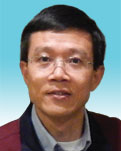Design Note 486: 2-Phase Synchronous Buck Controller Features Light Load Stage Shedding Mode, Active Voltage Positioning, Low RSENSE and Remote VOUT Sensing
Introduction
Today’s computer, datacom, and telecom systems demand power supplies that are efficient, respond quickly to load transients and accurately regulate the voltage at the load. For example, load current can be measured by using the inductor DCR, thus eliminating the need for a dedicated sense resistor. Inductor DCR sensing increases efficiency—especially at heavy load—while reducing component cost and required board space. The LTC3856 single-output 2-phase synchronous buck controller improves the accuracy of inductor DCR sensing by compensating for changes in DCR due to temperature. DCR temperature compensation is just one of many performance enhancing features offered in the LTC3856. It also includes on-chip gate drivers, remote output voltage sensing, Stage Shedding™ mode for improved light load efficiency and adaptive voltage positioning for fast transient response. The LTC3856 can convert a wide input voltage range, 4.5V to 38V, to outputs from 0.6V to 5V. Despite the many features, the chip is small, available in 32-pin 5mm × 5mm QFN and 38-pin TSSOP packages.
High Efficiency, 2-Phase, 4.5V to 14V Input, 1.5V/50A Output Converter
Figure 1 shows a typical LTC3856 application in a 4.5V to 14V input, 1.5V/50A output converter. The TC3856’s two channels operate out-of-phase, which reduces the input RMS current ripple and thus the required input capacitance. Up to six LTC3856s can be paralleled for up to 12-phase operation. The LTC3856 has a phase locked loop (PLL) and can be synchronized to an input frequency between 250kHz and 770kHz. Due to its peak current-mode control architecture, the LTC3856 provides fast cycle-by-cycle dynamic current sharing plus tight DC current sharing, as shown in Figure 2.

Figure 1. 1.5V/50A, 2-Phase Synchronous Buck Converter Featuring the LTC3856.
Stage Shedding Mode
At light loads, the LTC3856 can be programmed to operate in one of three modes: Burst Mode® operation, forced continuous mode or Stage Shedding mode. With Stage Shedding mode, the LTC3856 can shut down one channel to reduce switching related loss which is the dominant loss at light loads. Stage Shedding mode is selected by simply tying the MODE pin to INTVCC.
The efficiency improvements achieved by Stage Shedding mode are shown in Figure 3. Due to strong gate drivers and shorter dead-time, the LTC3856 can achieve 4% ~ 5% higher efficiency than the LTC3729, a comparable single-output, 2-phase controller, over the whole load range. With Stage Shedding mode, significant efficiency improvement is further achieved at light load. At 5% load, the efficiency is improved by 13%.

Figure 2. Load Transient and Current Sharing: VIN = 12V, 25A to 50A Load Step.

Figure 3. Efficiency Comparison: VIN = 12V, VO = 1.5V, FSW = 400kHz, L = 220nH, RSENSE = 1mΩ, QT = RJK0305DPB, QB = 2xRJK0330DPB.
Current mode control allows the LTC3856 to transition smoothly from 2-phase to 1-phase operation and vice versa.
Active Voltage Positioning
User-selectable active voltage positioning (AVP) is another unique design feature of the LTC3856. AVP improves overall transient response and reduces required output capacitance by modifying the regulated output voltage depending on its current loading. With proper design, AVP can reduce load transient-induced peak-to-peak voltage spikes by 50%.
Inductor DCR Sensing Temperature Compensation
Although not used here, inductor DCR sensing offers a lossless method of sensing the load current. The problem is that the DCR of the inductor typically has a positive temperature coefficient, causing the effective current limit of the converter to change with inductor temperature. The LTC3856 can sense the inductor temperature with an NTC thermistor, thereby adjusting the current limit based on the temperature. The result is a constant current limit over a broad temperature range. This improves inductor DCR sensing reliability in high current applications.
Output Voltage Remote Sensing
For high output current, low voltage applications, board or wire interconnect resistance can cause a severe load regulation problem. To solve this problem, the LTC3856 includes a low offset, unity-gain, high bandwidth differential amplifier for true remote sensing. Common mode noise and ground loop disturbances can be rejected, and load regulation is greatly improved, especially when there are long trace runs between the load and the converter output
Conclusion
The LTC3856 is a feature-rich single output, 2-phase synchronous step-down DC/DC controller. It achieves high efficiency in both heavy load and light load conditions, with temperature compensated DCR sensing and Stage Shedding mode or Burst Mode operation. AVP improves transient response even when the output capacitance is reduced. Remote sensing, a tight ±0.75% reference voltage accuracy over temperature, voltage tracking, strong on-chip drivers, multichip operation and external sync capability fi ll out its menu of features. The LTC3856 is ideal for high current applications and can meet the high standards of today’s power supplies for telecom and datacom, industrial and computer applications.

